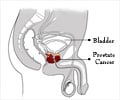Study of gene expression, using a technique called microarray analysis has let researchers to begin the process of identifying genes, which predispose to poorer prostate cancer outcomes.

The prognosis of men with prostate cancer is assessed using a grading system called the Gleason Grading System. The Gleason Score, as it is referred to, is used internationally to determine the severity of the cancer. It has acted as a decision maker that enabled physicians to choose from the different management options for the cancer. The Gleason system is based on the microscopic appearance of the tumor tissue. Patient’s tumor tissue is scored on the cell patterns.
A low Gleason score means the cancer is less likely to spread and is similar to normal prostate tissue. A high score points to a poorer prognosis. However, recent studies challenge this concept. It has been found that a number of men with low Gleason scores develop aggressive prostate cancers. A low score hence does not definitely mean that the cancer will not turn hostile.
It was thus necessary to devise a new system that could predict patients with low Gleason scores who will have poor survival. The research that followed led scientists to genes. Study of gene expression, using a technique called microarray analysis has let researchers to begin the process of identifying genes which predispose to poorer outcome.
Gene screening may allow the most lethal types of prostate cancer to be pinpointed earlier and more definitively than current tests, said researchers. The landmark study used data from 281 patients from Sweden who had been recruited between 1977 through 1999. Their tumour tissues were studied for genetic expressions associated with prostate cancer. Microarray analysis allowed the measurement of the expression of huge numbers of genes simultaneously.
Patients from the Swedish study were classified into five prostate cancer subtypes, each of which had a distinct predicted outcome. Two subtypes of prostate cancer were found to carry a 3.2-fold increased risk of death. These two high-risk subtypes had a number of men with poor prognoses even though they had low Gleason score tumors.
Reference: Proceedings of the National Academy of Sciences, November 28, 2011; Markert EK, Mizuno H, Vazquez A, Levin AJ. Molecular classification of prostate cancer using curated expression signatures.






![Prostate Specific Antigen [PSA] Prostate Specific Antigen [PSA]](https://www.medindia.net/images/common/patientinfo/120_100/prostate-specific-antigen.jpg)








